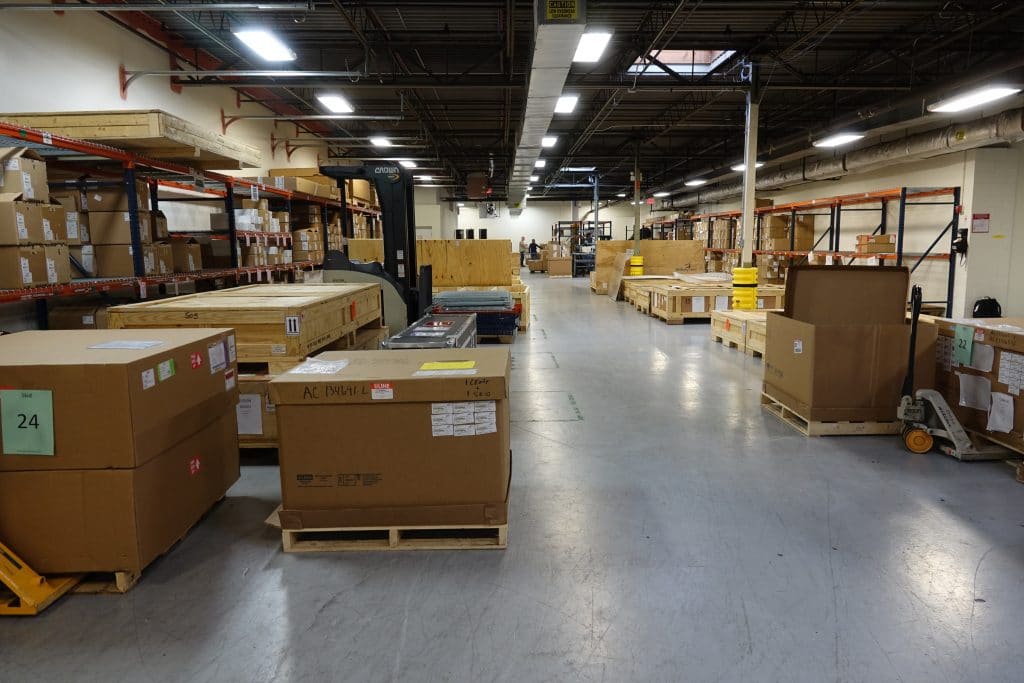
We have been working extremely hard to install as many new 2Ku equipped aircraft as possible. Installing 2Ku means taking a plane out of service for a couple of days, and mounting 2 large flat panel satellite antennas on top, then covering the antennas with a dome (called a radome). Work then moves to the cabin and avionics bay for installation of our airborne server, cabin wireless access points and other components (like power, fuses, switches and our content loader). We install the system at 24 different locations around the world, usually when the plane is already in a hangar for major maintenance.
Intelsat’s Kevin Brown is in charge of the facility and describes it like this: “We are the assembly plant for the world’s best Inflight Wi-Fi system. This is the main shipping and receiving hub. We are also the Service and Warranty center for the major system components. Through parts procurement, inspection, repair, testing and shipping we are proud to keep the airline passenger connected to the internet in flight (Even at 35,000 feet)”
The 2Ku system is extremely complex – and involves hundreds of components, from something as small as a washer to some the size of a small car. Getting all of these components correctly tested and packed is the job of our global logistics center. At this warehouse and technology center, we store all the parts needed for our various airborne systems in use today.
The facility is the starting point for any new installation – when an aircraft is scheduled to be outfitted with 2Ku, we need to get all of the parts shipped (and delivered) on a very strict schedule. In most cases, a plane is only available for a few days, so shipping delays would be unacceptable as it would mean missing a maintenance window that may not be available again for months.

What goes out the door for an installation is called a “shipkit”, and this kit (as seen above) includes everything required for the team working on the plane. For a 2Ku installation, this means we need to ship the following components:
- 2 Thinkom Satellite antennas
- Mounting ring adapter
- Composite radome
- Wiring harnesses
- Terrestrial antenna
- ACPU 2.0 (Airborne CPU)
- Modman and Kandu antenna controllers
- CWAPs (Cabin Wireless Access Points)
- Equipment racks with cooling hardware
- Content loader (used to load movies and TV shows for wireless inflight entertainment)
- Cabin handset
In addition to these major components, the shipkit also contains the thousands of screws and other small parts required for the installation. Because all of these parts will be installed on an airplane, we need to ensure everything is FAA approved. Every single component used for our installations is documented as part of the supplemental type certificate for the plane we are installing on. This means each different plane has its own version of a shipkit, with its own dedicated components. At our headquarters, we have engineering teams dedicated to documenting these kits and ensuring the installation partners have the diagrams and other paperwork required to proceed with the installation.

Our supply chain facility is FAA certified, and certain parts of the building are clearly marked “FOD free” (FOD is an aviation term for “Foreign Objects and Debris”). This ensures the shipkits only contain the parts needed with no unapproved parts. Many of the components are so important that we also test them before shipping, which is another important part of our facility.

The facility has several of these repair and test rooms, each managing different parts of our technology. The facility also manages warranty returns and hardware in need of special attention like firmware updates. Any equipment that is returned from a repair is tagged, tested and either repaired in-house, or sent back to the manufacturer. These tags are tracked through each step of the process.
Once the shipkit leaves our dock, the next step is of course shipping – our logistics partners are experts in moving this kind of equipment around the world in a timely manner. Below is a video showing the installation of 2Ku on a GOL Boeing 737-800 which clearly shows all of the parts coming together.


